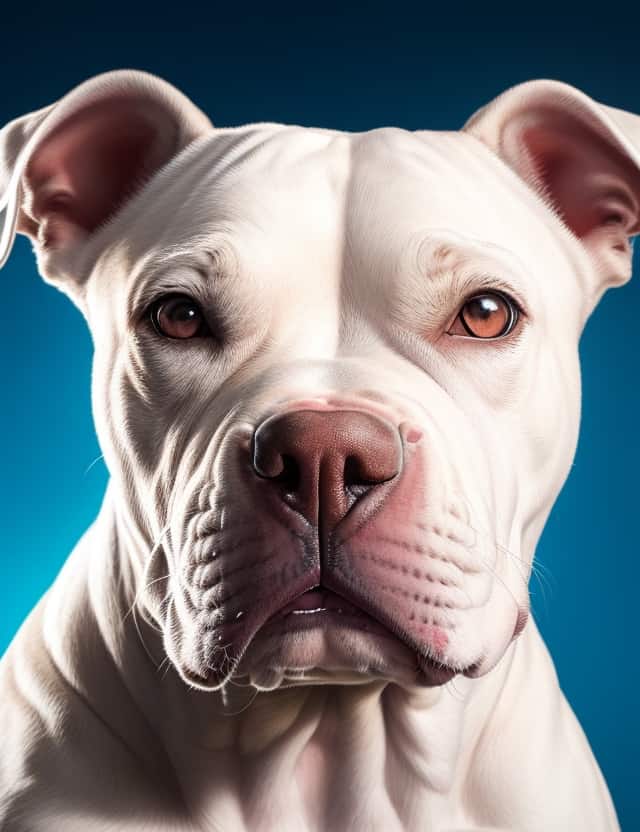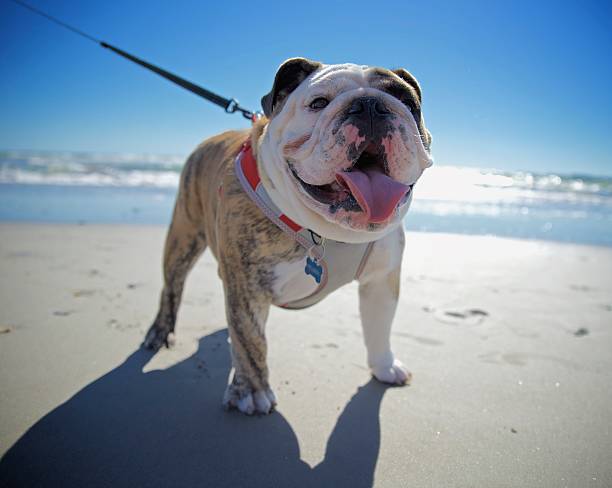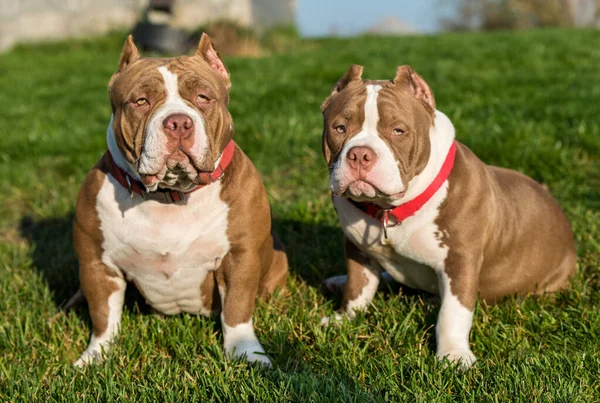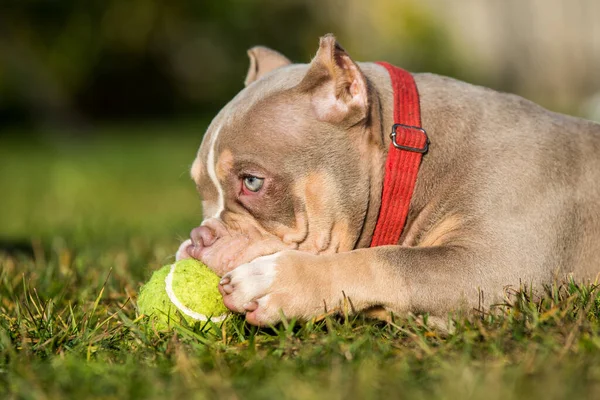The American Bully, a unique blend of strength, loyalty, and charm, has found a special place in the hearts of dog enthusiasts and families who appreciate both versatility and affection. With its distinctive appearance, friendly personality, and devotion, this breed has firmly established itself as a beloved family member and a symbol of modern canine companionship.

| Category (Explanation) | Breed Information |
|---|---|
| Year of Breed Conception | 1990s |
| Country of Origin | United States |
| Weight (Male) | 70-120 lbs (32-54 kg) |
| Weight (Female) | 60-100 lbs (27-45 kg) |
| Coat Type | Short, smooth |
| Color Variations | Various, including brindle and merle |
| Shedding Level | Low to moderate |
| Height (cm & in) | 43-51 cm (17-20 inches) |
| Breed Size | Medium to large |
| Trainability | Moderate |
| Mental Needs | Moderate |
| Intelligence Level | Moderate |
| Energy Level | Moderate to high |
| Agility | Moderate |
| Loyalty | High |
| Playfulness | Moderate to high |
| Exercise Needs | Regular exercise and play |
| Guarding Proficiency | Moderate |
| Sociability with Children | High |
| Barking Level | Low to moderate |
| Digging Tendency | Low |
| Destructive Behavior | Low |
| Drooling Level | Moderate |
| Obedience Level | Moderate |
| Apartment Friendly | Yes, with proper exercise and space |
| Inherent Prey Drive | Moderate |
| Physical Risk to Others | Low to moderate |
| Travel Fatality Risk | Low |
| Allergen Potential | Low (considered hypoallergenic) |
| Health Concerns | Hip dysplasia, joint issues |
| Average Life Expectancy | 10-12 years |











































































Woof Mastery is reader supported and our articles may contain affiliate links.
Instead of running third party ads that we have no control of we only use links from high-quality companies we are directly partnered with. Making use of these links come at no cost to you our reader, and in many cases have the extra benefit of discounted rates or sign up bonuses.
If you’re interested you can read more about our affiliate policy here.
We appreciate your support and always insure that the products and services we recommend are high-quality, helpful and relevant to the subject at hand!
The American Bully’s history is a modern tale of breeding innovation and adaptability. Originating in the United States in the late 20th century, this breed was selectively bred from various bulldog breeds, including the American Pit Bull Terrier, American Staffordshire Terrier, and English Bulldog.
The aim was to create a companion breed with a friendly temperament and unique appearance. The American Bully’s journey from a mix of bulldog breeds to a recognized breed illustrates their adaptability and contemporary appeal. Today, they are cherished for their affectionate nature, distinctive look, and their role as loyal family members, embodying the values of companionship and modern canine culture.

What sets the American Bully apart is its unique blend of strength and affection. These dogs are known for their muscular build and strong loyalty to their owners. American Bullies balance their powerful appearance with a gentle and loving nature, making them excellent family pets and loyal companions. Their ability to combine strength and affection makes American Bullies truly special.
The traditional role of the American Bully was to be a loving and loyal family companion. While they share ancestry with working and hunting breeds, they were primarily bred for their affectionate nature. Today, they excel in providing companionship and love to their owners, embodying the role of a cherished family pet.
American Bullies are renowned for their gentle and affectionate personalities. They are highly loyal, deeply loving, and incredibly protective of their families.
These dogs are often described as loyal and dependable companions, with a natural inclination to bond closely with their owners. American Bullies have an exceptional capacity for affection and are known to be deeply connected to their family members.
They take their role as protectors seriously and will do whatever it takes to keep their loved ones safe. Their intelligence and willingness to please make them responsive to training, and they thrive on positive interactions with their owners.
While they may be cautious around unfamiliar individuals, their loyalty to their owners is steadfast and profound. American Bullies beautifully blend strength with a loving disposition, providing both protection and a strong sense of companionship.
American Bullies are typically friendly, loyal, and affectionate dogs. While they are often loving towards their families, they may exhibit protective instincts that require training and socialization to prevent overprotectiveness.
Territorial behavior and occasional stubbornness can be addressed with consistent and patient training methods. Leash training is important due to their strength. Proper socialization often results in friendly interactions with other dogs and people, reflecting their well-adjusted and loving nature. American Bullies are known for their affectionate disposition and adaptability, making them great companions for various households.
American Bullies are medium to large-sized dogs known for their muscular and stocky build. They possess a square-shaped head with a broad, well-defined jaw and strong cheeks, conveying a determined and confident expression.
Their eyes come in various colors, typically round and expressive. Ears can be cropped or natural. These dogs have a short, dense coat that can have various colors and patterns. The coat accentuates their well-muscled frame. American Bullies feature a muscular neck, leading to a broad chest and sturdy, straight legs. The tail is typically short and low-set.
In terms of size, males typically stand between 17 to 20 inches (43-51 cm) at the shoulder, and females are slightly smaller. Weight ranges from 70 to 120 pounds (32-54 kg) for males, with females being lighter. Overall, American Bullies exhibit a compact and muscular appearance, reflecting their history as companion dogs with a strong, confident presence. Their appearance exudes strength, loyalty, and a friendly disposition.
American Bullies have a distinctive appearance with various color varieties that showcase their strength and confidence. The most common color variations include:
American Bullies have a low shedding level. They are not considered heavy shedders, and their shedding is generally minimal throughout the year. Regular grooming and brushing with a soft bristle brush can help manage shedding and maintain their coat’s health.
Factors that affect shedding in American Bullies are genetics and overall health. Regular exercise, a balanced diet, and providing mental stimulation are essential for overall health and coat care, potentially reducing shedding.
American Bullies, a symbol of power and poise, prides themselves on their glossy and smooth coat.
Brushing: A weekly ritual involving a rubber grooming mitt, followed by a medium-bristle brush, can help in the effective removal of loose hairs, ensuring a lustrous coat. This activity also provides an opportunity to check for any skin issues, lumps, or parasites.
Bathing: Given their active disposition, they might benefit from a monthly bath, especially if they frequent parks or open spaces. A moisturizing shampoo, followed by a conditioner, can add an extra layer of protection to their coat.
Ears: Their ears, while sturdy, can trap moisture. Weekly cleaning with a vet-approved solution, combined with daily checks, can be instrumental in preventing ear infections.
Nails: Their nails, if left unchecked, can affect their movement. Regular trimming, ideally every 2 weeks, complemented by occasional filing, ensures they’re at their agile best.
Teeth: Their broad muzzle can be a hub for dental issues. Daily brushing, combined with dental chews and a balanced diet, can ensure their oral health remains intact.
Wrinkle Care: The breed’s distinct wrinkles, especially around the face, demand daily cleaning. Using baby wipes or a damp cloth, followed by thorough drying, is key.
Eye Care: Their eyes, often a window to their well-being, require daily checks and cleaning.
American Bullies have a moderate activity level. They are known for their affectionate and friendly demeanor. Here are some key points to consider about their activity level:
American Bullies exhibit moderate intelligence, characterized by adaptability, problem-solving abilities, and a strong inclination to please their owners. Here are key characteristics highlighting their intelligence:
While not the smartest, American bullies excel as watchdogs and affectionate family companions. Training, socialization, and mental stimulation are essential for them to reach their full potential.
American Bullies benefit from mental challenges. Engage them with brain games, obedience drills, or interactive play.
Social Interaction: They are family-oriented canines and require consistent interaction with their human counterparts. Neglect can result in emotional distress.
Exercise: Physical activity is vital not just for their physical health but also for mental well-being. Regular workouts can deter negative behaviors.
Training and Obedience: American Bullies respond well to obedience lessons. It’s not only mentally enriching but strengthens the human-canine relationship. Positive, reward-based methods work best.
Routine and Structure: They prefer a well-settled routine. A predictable day-to-day life can make them feel more at ease and anchored.
Affection and Attention: Shower your American Bully with love and dedicated time. Their loyal nature means they deeply value human companionship.
Socialization: Early exposure to varied settings, beings, and experiences is pivotal for an American Bully. It ensures they grow into confident and adaptable adults.
Safe Environment: Ensure a cozy, secure space at home where your American Bully can unwind and feel protected. A dedicated area for downtime can be beneficial.
Consistency: Being consistent in commands and daily rituals makes an American Bully more assured and settled in their surroundings.
Enter The Woof Mastery

Before welcoming an American Bully into your home, it’s important to understand their unique needs. American Bullies are known for their gentle and friendly personalities. They require regular exercise and mental stimulation to stay happy.
Training and socialization are essential to ensure they are well-behaved. Be prepared for potential breed-specific laws in your area. Responsible ownership involves providing ample love, attention, and a secure environment for these loyal and affectionate companions.
American Bullies, bred for their companionable nature, have the potential to pose a physical danger if not appropriately socialized, trained, or managed. A dog’s behavior rests on factors like temperament, upbringing, training, and owner dedication. Here’s their potential danger assessment:
American Bullies are renowned for their gentle and affectionate personalities. They are highly loyal, deeply loving, and incredibly protective of their families.
These dogs are often described as loyal and dependable companions, with a natural inclination to bond closely with their owners. American Bullies have an exceptional capacity for affection and are known to be deeply connected to their family members.
They take their role as protectors seriously and will do whatever it takes to keep their loved ones safe. Their intelligence and willingness to please make them responsive to training, and they thrive on positive interactions with their owners.
While they may be cautious around unfamiliar individuals, their loyalty to their owners is steadfast and profound. American Bullies beautifully blend strength with a loving disposition, providing both protection and a strong sense of companionship.
American Bullies, known for their compact, muscular build, and friendly disposition, bring with them certain swimming attributes. Here are some factors:
While some American Bullies might manage to swim and enjoy water activities, always be observant of their limitations and prioritize safety.
American Bullies, in line with their canine counterparts, have a unique set of vocalizations for communication. Here’s a look into their vocal world:
Understanding an American Bully’s vocalizations and the context is essential for owners. While many sounds are part of their vibrant character, others could signal discomfort or a specific need. Employing positive reinforcement can be handy in guiding their vocal habits.
American Bullies thrive in homes where they receive love, structure, and opportunities for socialization. Here are some ideal living conditions for American Bullies:
Challenges:
When it comes to travel fatality risk for the American Bully, consider the following potential constraints.
Considering these pointers and taking the necessary measures, you can ensure a safer travel experience with your American Bully.
American Bullies may be prone to specific health concerns. While not all individuals will experience these issues, it’s essential for American Bully owners to be aware of potential health problems and work with veterinarians to maintain their pets’ well-being. Common health concerns in American Bullies include:
Regular veterinary check-ups, a balanced diet, proper exercise, and responsible breeding practices can help mitigate some of these health concerns. It’s crucial for American Bully owners to work closely with their veterinarians to monitor their pets’ health and address any issues promptly.
To ensure the health and vitality of American Bullies, it’s crucial to follow these specialized nutritional habits and best practices tailored to this breed:
Breed-Specific Laws (BSL): American Bullies, despite being distinct from Pit Bulls, might be subjected to breed-specific laws (BSL) in some regions due to resemblances with breeds often covered by BSL. These laws are typically enacted at the local or city level.
Types of Restrictions: BSL for American Bullies could include mandatory spaying/neutering, unique licensing, obligatory liability insurance, muzzling in public areas, and in some situations, outright bans on ownership, all depending on local ordinances.
Rationale for BSL: BSL often emerges from public safety concerns related to certain breeds. Although American Bullies are bred for a gentle temperament, potential misunderstandings due to their appearance can lead to BSL issues.
Controversy: The efficacy and appropriateness of BSL remain debated, with many emphasizing the importance of responsible pet ownership and training over breed bans.
Local Regulations: Those considering an American Bully should ensure they are well-versed in local breed-specific regulations by consulting with local authorities.
Woof Mastery is reader supported and our articles may contain affiliate links.
Instead of running third party ads that we have no control of we only use links from high-quality companies we are directly partnered with. Making use of these links come at no cost to you our reader, and in many cases have the extra benefit of discounted rates or sign up bonuses.
If you’re interested you can read more about our affiliate policy here.
We appreciate your support and always insure that the products and services we recommend are high-quality, helpful and relevant to the subject at hand!
Myth 1: American Bullies are Aggressive by Nature
Myth 2: They are High-Energy Dogs
Myth 3: They Can’t Tolerate Cold Weather
Myth 4: They are Not Good with Children
Myth 5: They Shed Excessively
Myth 6: They Don’t Require Training
Myth 7: They are Always Good with Other Dogs
Myth 8: They Are All the Same Size
Myth 9: They are Unhealthy Dogs
Myth 10: They are Always Clingy
The American Bully holds cultural significance in various contexts:
While there may not be as many famous American Bully owners as there are for other dog breeds, here are a few notable individuals who have been associated with American Bullies:
American Bullies, like many other dog breeds, have faced several threats and challenges over the years. Some of the significant threats and issues that have affected the breed include:
The American Bully is believed to have been developed from a combination of various breeds, with the primary ancestors being the American Pit Bull Terrier and the American Staffordshire Terrier. The breed’s development was aimed at creating a companion dog with a gentler temperament. The specific breeds and strains that contributed to the American Bully’s development include:
American Bullies are a unique blend of strength and affection, epitomizing the spirit of cherished family pets. With their muscular build and loving disposition, they effortlessly integrate into our lives, becoming cherished members of our households.
These dogs excel as watchdogs, displaying protective instincts that solidify their role as guardians of our homes. American Bullies are known for their adaptability, thriving in various living conditions, and requiring only minimal grooming. Their athletic prowess and playful spirit cater to active individuals and families, making them excellent playmates. Their intelligence shines in activities and training.
Beyond their physical attributes, American Bullies bring a unique charm to every household, filling the air with their presence. Their versatility is a testament to their adaptability, transitioning effortlessly from beloved family pets to diligent working dogs.
Most importantly, American Bullies offer an unparalleled gift—profound and unconditional love. They become treasured family members, enriching our lives with their unwavering companionship and forging an unbreakable bond that lasts a lifetime. Embrace the incredible love and devotion that American Bullies have to share.